
|   |

|   |
 e-mail: sunilkothari1933@gmail.com 8th edition of Nrityantar's Naman Festival Photos: Shandilya Srivatsa September 6, 2017 Madhulita Mohapatra, a disciple of Aruna Mohanty, has done her guru proud. When Madhulita planned to settle down in Bangalore, Aruna lent her all assistance and support. Within a period of eight years with untiring zeal, hard work and passion Madhulita has been teaching Odissi to several young spirants and school children. Over the years she has evolved her technique of teaching children with such affection and care that they perform with confidence. Two six year old girls Shrinika and Angeleena Avnee have under her training displayed great promise as child prodigies. Every year in August, Madhulita's institution Nrityantar holds a two day festival Naman, showcasing the progress made by her over 200 students from six branches across Bangalore. They include senior dancers who are part of her choreographic works. She invites established Odissi dancers from Bhubaneswar to the festival with a view that not only her students but also the Bangaloreans get an opportunity to witness senior dancers. This year was an artistic coup on Madhulita's part to invite three celebrated dancers in solo performances on the second day - Sharmila Biswas from Kolkata, Aruna Mohanty from Bhubaneswar and Surupa Sen of Nrityagram from Bangalore. Therefore there was a buzz about their participation when their names were announced. And they gave their best to the Bangalore audience with their creative works. On the first day, as usual, the senior dancers who have been learning under Madhulita from the beginning and the younger dancers plus the school children took to the stage and offered quite a varied fare of Odissi repertoire. With the pallavis of revered gurus including Pankaj Charan Das, Kelucharan Mohapatra, Gangadhar Pradhan and Ratikant Mohapatra, Madhulita gave one an idea of the creative efflorescence of Odissi dance form and its evolution. Some of the pallavis are exquisite gems and revisiting them gives one an idea of how they have an ability to remain fresh even after several years. To wit, Saveri pallavi of Kelubabu and one choreographed by his son Ratikant in Megh raga, Madhulita's own choreography of Jansammohini raga pallavi, were an interesting exercise to relish. 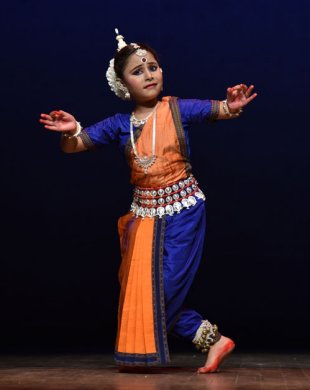 Angeleena Avnee 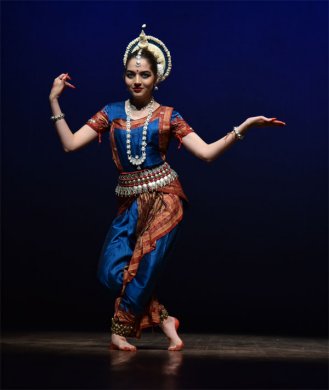 Freya Stamets 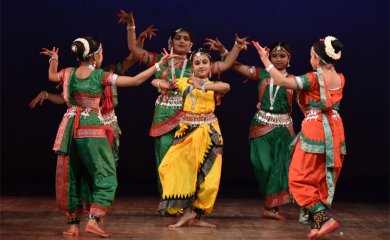 Nrityantar students 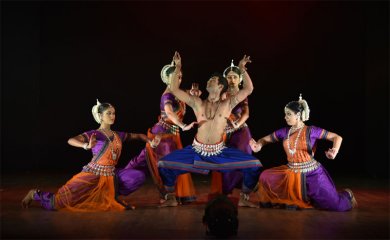 Nrityantar dance ensemble Children always steal the show. After Shrinika, it is now Angeleena Avnee who captured attention of all with her flawless performance to the song 'Radharani.' The innocence aside, the confidence to execute the footwork, maintain tribhanga, and wear expressions appropriate to the song also spoke of Madhulita's training and bringing out the best in her. The song with exquisite poetry describing Krishna holding flute as Muralipani, with the rhyming word Radharani, creates images of the divine pair. Here is a child prodigy and with support of her parents and guidance from Madhulita, she is bound to go places. Dancer Freya's father is American and mother Bengali. During their stay in Bangalore for more than six years, their daughter loved learning dance. Freya showed considerable competence in performing to "Pransangini re," capturing the nuances of embarrassment of Radha when Krishna in disguise as a beautiful woman came to her abode to put mehandi/alata on her feet. Then on the sole of Radha's foot she wrote name of Krishna; looking at it Radha got annoyed and looked carefully at the disguised female and realized it was Krishna! The subtle nuances of enjoying Krishna's presence, the resultant embarrassment when his name was written on her sole, her shame but enjoyment of Krishna's deceit, she narrates to a friend with delight. Freya did justice to the number. The duet 'Braja Juvaraj' by two young dancers dwelt upon the mischief of Krishna, whose irresistible beauty, the gopis fell prey to. Promising to ferry them across river Yamuna and making advances to them, the two gopis spoke of Krishna's various ways of harassing them, which they secretly enjoyed. Group choreography for ashtapadi "Chandana charchita" had a young boy dancing joyously as Krishna with other dancers describing poet Jayadeva's description of Pitavasana Vanamali, dressed in yellow robes with garland of flowers. The composition for group offered scope for dancers to play roles of various gopis with whom Krishna dallied. Among senior dancers Rashmi Diwakaran who had grown up with Guru Gangadhar Pradhan and is now with Madhulita, Devarati Dutta, stand out for their sound technique. The group choreography of "Shivam dhi mahi" with Nityananda Mishra's Sanskrit text, Madhulita's use of Sabdaswarapata, the four female dancers Paridhi, Vivekini, Aswasana and Sahana with male dancer Kohal Das, was of professional level. Madhulita displayed imagination in its interpretation. The nritta was energetic. Kohal Das as Shiva, able to raise his leg in Urdhva Tandava pose effortlessly, the four female dancers performing on either side forming interesting visuals for epithets of Shiva, the sound texture with gham gham for damaru, and the dancers standing creating multi-armed image of Shiva all made the piece attractive. In particular, Kohal Das was impressive as Shiva. On the second day, this number was repeated in the beginning. 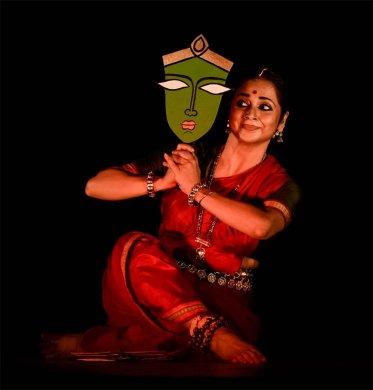 Sharmila Biswas
Photo: Akila Venkat Sharmila Biswas appeared on the stage with her commanding stage presence narrating the story of Katha Shurpanakha, mentioning how Valmiki has described her as Virupa, unattractive, Mahaghora, fearsome, raining blood, bringing ill luck, an image from Treta Yuga that persists till today, but her Shurpanakha is different. Drawing from Odiya poet Upendra Bhanja's Vaidehisa Vilasa, Vishwanath Khuntia's Vichitra Ramayana, Balarama Das's Dandi Ramayana, Sharmila created a beautiful Shurpanakha with dramatic effect from her perspective, as sister of Ravana, princess, moving freely in Dandakaranya, frolicking in river Godavari and watching footprints of some strangers, wondering who they could be. Following the footprints she saw two handsome male figures and a beautiful woman. She immediately fell in love with the handsome male and decided to go unto them. But before that she looked at her own image in the water and did not find it any match to their beauty. So she transformed herself into a beautiful maiden and proceeded to where Ram, Lakshmana and Sita were, approached them and unabashedly asked Ram to marry her. Ram asked her to approach Lakshmana. She was made to run between them and was humiliated. She then angrily attacked Sita when Lakshmana defaced her. Running back she looked at her face in waters of Godavari and was further distressed before returning to court of Ravana seeking revenge on those who humiliated her. Enacting these episodes as a prologue Sharmila used several masks to depict various states of young princess Shurpanakha, her beauty and transformation into a beautiful princess to entice Ram, then humiliated and defaced one, raising her arms, rolling on floor with agony. When she moved to meet the two princes while transforming, she used tribal sounds artistically, for her soliloquy, with well conceived music by Prafulla Kar and rhythm by Dhaneswar Swain. Sharmila did not show Lakshmana rushing to her and cutting off her nose, instead she sat in agony near bank of Godavari seeing her reflection. There were several such artistic touches which place her as a gifted choreographer and performer. So powerful is her abhinaya that the audience is glued to their seats, even when they know the story. Her story of Shurpanakha is different and stands out from clichéd one generally seen on stage. Indeed her performance was tour de force. Bravo Sharmila. Always exploring new themes for her choreography, Aruna followed with another powerful performance on the theme of Pratinayaka, conceptualized by poet Kedar Mishra. He wrote the libretto taking three mythological nayakas and pratinayakas. The existential philosophy 'I am, therefore you are' was epitomized in Satyayuga when Hiranyakashipu as a Pratinayaka challenged Vishnu as Nayaka. Listening to chanting of 'Hari Hari' by son Prahlada, the demon king challenges him to show omnipresence of Vishnu, striking the pillar and as Narasimha, nayaka Lord Vishnu appears and Hiranyakashipu is vanquished. Aruna used a throne sitting on it to show power of the king, muscle power, and also shadow using white cloth, behind which she performed as Narasimha killing Hiranyakashipu. It was a striking visual. In Dwaparayuga, Aruna dwelt upon episode from Ramayana, Ravana in disguise as mendicant, bhikshan dehi, then kidnapping Sita, as Ram, crossing the setu and in duel Ravana getting killed. The quick changes of roles were performed by Aruna in a seamless manner. Using suggestive props like bow and arrow placed in one corner, as a choreographer she showed presence of Ram symbolically. In Tretayuga, the suggestion of nayaka and pratinayaka was based on story from Maha Bhagavatapurana. Krishna in duel was to kill Kamsa. Aruna showed Kamsa, pratinayaka, in fear and confusion when he recalled the akashavani that the eighth child of Devaki would kill him. Aruna displayed it in abhinaya competently. The suggestion of Krishna was also shown by placing in one corner, the peacock feather and flute. Balarama and Krishna arrive driving a chariot and Krishna confronting Kamsa was shown dramatically. Aruna as a choreographer built up the scenes evoking the final denouement. In Kaliyuga, evil as omnipresent element, existing side by side of truth was conceived as pratinayaka. Greed while playing game of dice, lust for women, using musical refrain ta jham ta jham for dancing depicting charms of women for attracting men, drinking of wine, how they lead to destruction and because there is evil, there is good and it wins over evil - both exist. Aruna showed it suggestively by using a balance with two sides as symbol. Singing by Ramhari Das and rhythm by Dhaneswar Swain were effective as per the episodes and the work stood out for exploring philosophical theme. 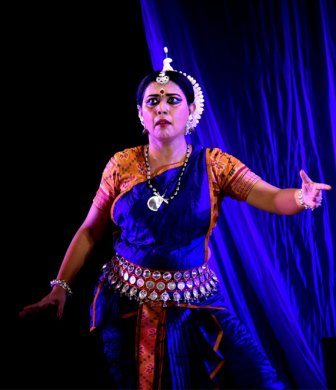 Aruna Mohanty 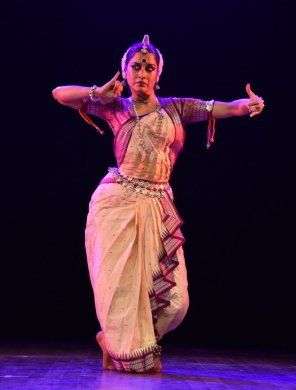 Surupa Sen Surupa Sen from Nrityagram, thanking Madhulita, said that she was appearing after ten years in a solo performance, as she has been dancing with Nrityagram Ensemble. She has been listening to various genres of classical music intently and had conceived her three solos to different genres of Indian classical music and form. Taking Sanskrit composition Bhavayami Gopalabalam, to the Carnatic music rendered by Ranjani and Gayatri, Kaushiki Chakravarty's thumri for abhinaya in Hori, a traditional Meera Bhajan, and Gita Govinda ashtapadi Kuru Yadu Nandana as composed by Raghunath Panigrahi, she explored these musical forms in her solo Odissi recital. The melodious singing of Ranjani and Gayatri offered scope for predominantly vatsalya bhava and deeds of Krishna, his divine beauty, taming Kaliya, killing Putana, stealing butter and while eating earth, showing Yashoda three worlds in his mouth, and decorated as child with ornaments which make musical sounds, her rendering in the bani of Nrityagram as it has evolved was enchanting. More challenging was the depiction of playing Hori with Krishna to the singing of thumri, Mat maro Shyam, throwing of colour and playing with syringe, begging Krishna to release her palm, blocking her way to go to Jamuna to fetch water et al evoked a strong recall to Kathak, as the thumri is often sung for abhinaya in Kathak. Meera bhajan rendered by Odiya vocalist Jatin Sahoo showed Surupa dancing abundantly, suggesting the deep fondness for Krishna bordering madness. Not bothering about social norms, her intense feelings for Krishna like chakore bird longing for moon, like Jal bin machali - fish cannot live without water - dancing and singing, holding idol of Krishna, Meera's state was portrayed effectively. Lynne's light design to show Krishna's presence with spotlight symbolically was imaginative. Her light design for all four numbers had unmistakable stamp of her virtuosity. With a catch in her throat, Surupa mentioned that Protima had started teaching her Kuru Yadu Nandana ashtapadi and half way through, she was hospitalized with a stroke. But she had called Surupa to hospital and sitting in the bed completed teaching her the ashtapadi. She presented it more in a spirit of tribute to her guru Protima. This is an all time classic choreographic gem of Guru Kelucharan Mohapatra. In essence it reflected that spirit. Radha's requesting Krishna to paint design of creepers with sandal paste on her breasts; while making love the flowers which fell, placing them in her hair, (ratigalite kusumani) - the exquisite description by Jayadeva morphing in abhinaya is evergreen and has acquired a permanent place in hearts of rasikas. Surupa's internalizing it and performing it with intensity was touching. Few responses to her exploring the different genres of music. How to blend the technique of Odissi to these musical forms so that they do not evoke conditioned familiar responses? Transcending the grammar of Odissi merging with the mood of music chosen for exploration, say in song in Carnatic music, thumri in Hindustani gayaki form, how to evolve dance so that there is no recall to conditioned responses? It is a big challenge and die hard followers of classical form of Odissi are bound to raise their eyebrows. At the end of the performance the audience gave a standing ovation for all the three dancers. It was indeed a remarkable evening to see these three contemporary dancers, free from prima donna syndrome, sharing a common platform with respect for each other. Nrityantar as an organization and Madhulita at the helm of affairs creating such an event indeed deserve congratulations as much as the three dancers.  Dr. Sunil Kothari is a dance historian, scholar, author and critic and fellow, Sangeet Natak Akademi. Comments * What a beautifully written review. You have walked miles, holding the hands of dancers, sharing all their agonies and delights. Katha Surpanakha is not just an episode from Ramayan; through this piece, I reach out and talk about many thoughts which come to me - as a person, as a dancer. - Sharmila Biswas (Sept 7, 2017) Post your comments Please provide your name and email id when you use the Anonymous profile in the blog to post a comment. All appropriate comments posted with name & email id in the blog will also be featured in the site. |